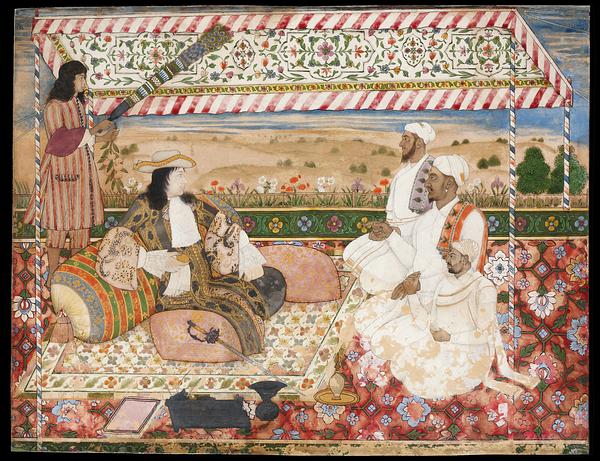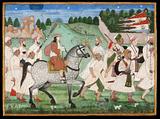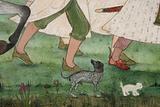Two miniatures. ‘The Darbar of Cornelis van den Bogaerde’ and ‘The procession of Cornelis van den Bogaerde’
India, Deccan, Golconda; c. 1687
20.5 × 25.1 cm (43/2008)
16.5 x 22.5 cm (42/2008)
The Dutch had had trading posts on India’s southeastern Coromandel Coast from the 16th century, but in the 17th were given competition from other European countries, including France, Britain, and Denmark.
The main figure in European dress has been identified as Cornelis van den Bogaerde. Bogaerde was in charge of the Dutch trading post in Hyderabad in the Islamic state of Golconda, and it was a local painter who made the two miniatures.
On one of the miniatures, Cornelis van den Bogaerde is depicted in a darbar similar to the princely audiences that are known from Mughal art, though they most often have a larger number of figures. Bogaerde is more elegant in this miniature than in the procession scene. He is dressed in the newest European fashion as it emerged from the court of Louis XIV at Versailles.
Nonetheless, the scene is rendered in the relaxed style that is characteristic of court art in Golconda. Bogaerde reclines comfortably while his Indonesian servant, in suitable European garb, stands behind him with a gigantic fan of peacock feathers and a branch from a fruit tree – an allusion to the origins of his surname (Dutch for an orchard). He is conversing with three merchants, two of whom with marks on their foreheads are Hindus. The man in the middle seems to be leading the discussions and is also the largest (the most important). The rendition is colorful, and the portraits of the characters are vividly yet precisely conceived.
On the other miniature we see Bogaerde with his Indian entourage, whose different garments, headgear, beards, and skin color show that they are Muslims, Hindus, and the famed Rajput warriors. Some carry his weapons, others his fan, pipe, etc. Two of the Dutch East India Company’s banners head the procession.
‘The procession of Cornelis van den Bogaerde’
Detail - ‘The procession of Cornelis van den Bogaerde’
Inv. no. 43/2008 & 42/2008
Published in:
43/2008
Olivier Coutau-Bégarie, 4/10-2008, lot 245;
Gijs Kruijtzer: “Pomp before disgrace: a Dutchman commissions two Golconda miniatures on the eve of the Mughal conquest” in Journal of the David Collection, 3, 2010, fig. 1 og 2, pp. 160-163;
Diana Scarisbrick and Benjamin Zucker: Elihu Yale: merchant, collector and patron, London 2014, p. 37, fig. 9;
Navina Najat Haidar and Marika Sardar: Sultans of Deccan India, 1500-1700: opulence and fantasy, Metropolitan Museum of Art, New York, New Haven 2015, cat.no. 194;
Jos Gommans: “Merchants among kings: Dutch diplomatic encounters in Asia” in Karina H. Corrigan, Jan van Campen, and Femke Diercks (eds.): Asia in Amsterdam : the culture of luxury in the Golden Age, Rijksmuseum Amsterdam, Salem 2015, p. 33, fig. 1;
Niels Brimnes (ed.): Indien: Tranquebar, Serampore og Nicobarerne, [København] 2017, p. 53;
Kjeld von Folsach, Joachim Meyer: The Human Figure in Islamic Art – Holy Men, Princes, and Commoners, The David Collection, Copenhagen 2017, cat.no. 41, p. 168-169;
Jos Gommans: The unseen world: the Netherlands and India from 1550, Amsterdam 2018, fig. 2.41A, p. 141;
Guido van Meersbergen: Ethnography and encounter. The Dutch and English in seventeenth-century South Asia, Leiden 2021, fig. 8, pp. 168-169;
42/2008
Olivier Coutau-Bégarie, 4/10-2008, lot 245;
Gijs Kruijtzer: “Pomp before disgrace: a Dutchman commissions two Golconda miniatures on the eve of the Mughal conquest” in Journal of the David Collection, 3, 2010, fig. 3, pp. 164-165;
Navina Najat Haidar and Marika Sardar: Sultans of Deccan India, 1500-1700: opulence and fantasy, Metropolitan Museum of Art, New York, New Haven 2015, cat.no. 195;
Jos Gommans: “Merchants among kings: Dutch diplomatic encounters in Asia” in Karina H. Corrigan, Jan van Campen, and Femke Diercks (eds.): Asia in Amsterdam : the culture of luxury in the Golden Age, Rijksmuseum Amsterdam, Salem 2015, p. 33, fig. 2;
Kjeld von Folsach, Joachim Meyer: The Human Figure in Islamic Art – Holy Men, Princes, and Commoners, The David Collection, Copenhagen 2017, fig. 42, p. 169;
Jos Gommans: The unseen world: the Netherlands and India from 1550, Amsterdam 2018, fig. 2.41B, p. 141;
Le monde à portée de sens: un cabinet de curiosités chez Christophe-Paul de Robien au XVIIIe siècle, Musée des beaux-arts de Rennes, Rennes 2020, fig. 218, p. 311;
Guido van Meersbergen: Ethnography and encounter. The Dutch and English in seventeenth-century South Asia, Leiden 2021, fig. 9, pp. 169-170;



